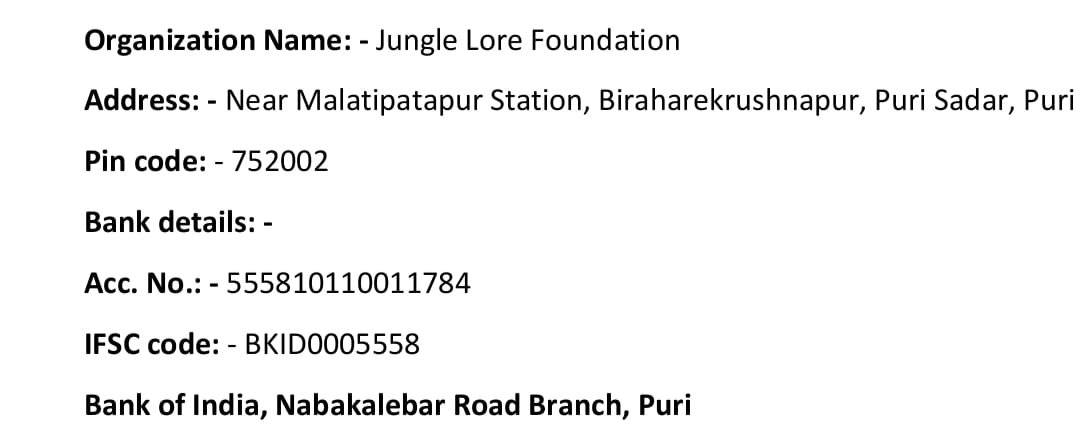Conservation of Sea turtles
 Conservation of Sea turtles Non violated seascapes
Conservation of Sea turtles Non violated seascapes
The most common sea turtles (Lepidochdys Olivia) and their ecology pertaining to entire Puri coast is scanty and population is still declining. Encroachment of nesting beaches, development projects, unusual deaths, unscientific fishing practices and mortality of adult turtles in breeding grounds for various reasons lead to severe population decline as matured turtles and their eggs are lost forever. Population information, arrival and departure pattern and their threats in some unprotected areas are important for proposing conservation strategies for species. Here we propose and outline measures to conserve these species and strategies to be adopted for long term survival along Puri coast are given below.
















Jungle lore foundation is a registered organization involved in a unique exercise to protect these endangered marine turtles from its arrival. In this regard we started with some volunteers, Forest Department,that lead to a magnificent development protecting these species and eggs from human consumption and excess predation.
Marine biodiversity conservation, turtle protection and environmental recovery are effective strategies for achieving sustainable dev. In this regard public and private organisations should work together. Responsible organisations, the stakeholders at different level and the public must be trained and introduced to the latest scientific methods. Rules, policies and implementations should be reviewed and revised in a very urgent basis.
Puri and Chilika Wildlife divisionsare among 6 marine districts of Odisha crises crossed by several rivers and distributaries. The entire beach has sandy areas and ideal breeding grounds for many marine species. We undertook surveillance and patrolling in coordination with turtle watchers, locals, local NGOs and the outing had an excellent effect on the general populace, as a symbol of turtle conservation through people’s participation was discernible for all to see. The general public became associated with this exercise and there was a general mature of enthusiasm amongst all.
Strategies adopted: –
- Engaging frontline forest protection personnel.
- Involving institutional setups by district administration like eco club VSSs for more relevant interface with local communities.
- Engaging youths in potential nesting areas.
- Awareness through capacity building programs.
- Questioning survey to learn about the species conception among community.
- Plastic clean drive.
- Setting up potential hatcheries through Puri Wildlife Division.
Objectives: –
- To bridge and develop communication and local inhabitants and local forest department adopting multi stakeholder’s approach.
- Need for monitoring presence of Olive Ridley.
- Motivating frontline forest staffs, intelligence and information collection from the sensitive and high priority areas.
- Creating and promoting conservation awareness programs for stake holders for areas sensitive from marine species perspective.
Activities: –
- Successfully conducted 6Nos of Estuaries clean up drives before nesting with the support of Puri Wildlife Division, Chilika Wildlife Division, Beach management committee, Puri district Administration, Boat associations of Chilika, local youths etc. These cleanup drives gave us much energy for this conservation movement.
Sites are: – Kadua, Kushabhadra, Nuanai, Mangala, Moto and Arakhakuda.
As a result, for the 1st time Brahmagiri Range witnessed arrival of turtles to lay eggs after 2012.
- Participated and presented PPTs on every range by a unique and selfless approach. Some documentaries on Olive Ridley Sea turtles also highly appreciated and all events are successful to a great extent.
- Some suggestions are successfully adopted and implemented by DFO, Puri like hatchery management, egg collection and monitoring, burying of dead turtles, engaging coast guards etc.
- Successfully able to unite turtle’s conservation organization under Forest Department for better conservation and management of this marine species.
- Intended to carry on the good work in the form of patrolling during odd hours, educating the ground level turtle protection squads, noting individual species, observing their behavior etc.
- Helped and designed advisory hoardings indicating different threat perceptions.
- Supported Brahmagiri range installing a new hatchery for better conservation of turtle eggs.
- Presented some torches to turtle watchers for better night patrolling.
- Constant pressure on some NGOs adding more volunteers to collect eggs.
- Direct and indirect involvement of seizing two trollers and successfully released 4 trapped turtles.
- Here at moto, Narasinghapatna and Sipasurabaliturtle eggs were being regularlycollected by the locals and mostly consumed. With constant patrolling this practice now appears shunned. This changed scenario can but lead to a much safer habitat for Olive Ridley Sea Turtles.
- The most satisfying aspect of egg monitoring to educate and create awareness (telling turtle story) among those early morning beach movers and using their expertise to detect nests, identifying false nests was one of the basic causes of success.
- Spending above 30 sleepless nights on coast with turtle watchers, NGOs and Forest personnel for better conservation of Olive Ridley sea turtles.
Suggestions: – Olive Ridley sea turtles feed on invertebrates and may play roles in both open ocean and coastal ecosystems.
- Local communities with frontline forest personnel should be trained in order to continue long term conservation plan.
- Educating villagers in coastal regions adjacent to Aribada sites and in schools.
- Establishing more observation camps near the coast and protection of the turtles and their eggs during nesting period.
- Security personnel in speed boats must ensure that the coast is guarded to prevent the entry of illegal traders.
- Reducing by catch and promoting smart fishing.
- Check on egg consumption by way of regular patrolling.

